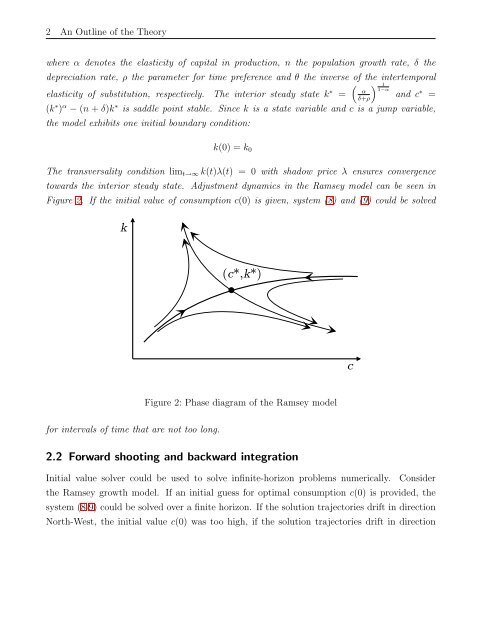Dynamic Macroeconomic Modeling with Matlab
Dynamic Macroeconomic Modeling with Matlab
Dynamic Macroeconomic Modeling with Matlab
You also want an ePaper? Increase the reach of your titles
YUMPU automatically turns print PDFs into web optimized ePapers that Google loves.
2 An Outline of the Theory<br />
where α denotes the elasticity of capital in production, n the population growth rate, δ the<br />
depreciation rate, ρ the parameter for time preference and θ the inverse of the intertemporal<br />
elasticity of substitution, respectively. The interior steady state k ∗ =<br />
1<br />
α 1−α<br />
δ+ρ<br />
and c ∗ =<br />
(k ∗ ) α − (n + δ)k ∗ is saddle point stable. Since k is a state variable and c is a jump variable,<br />
the model exhibits one initial boundary condition:<br />
k(0) = k0<br />
The transversality condition limt→∞ k(t)λ(t) = 0 <strong>with</strong> shadow price λ ensures convergence<br />
towards the interior steady state. Adjustment dynamics in the Ramsey model can be seen in<br />
Figure 2. If the initial value of consumption c(0) is given, system (8) and (9) could be solved<br />
<br />
for intervals of time that are not too long.<br />
<br />
Figure 2: Phase diagram of the Ramsey model<br />
2.2 Forward shooting and backward integration<br />
Initial value solver could be used to solve infinite-horizon problems numerically. Consider<br />
the Ramsey growth model. If an initial guess for optimal consumption c(0) is provided, the<br />
system (8-9) could be solved over a finite horizon. If the solution trajectories drift in direction<br />
North-West, the initial value c(0) was too high, if the solution trajectories drift in direction
















